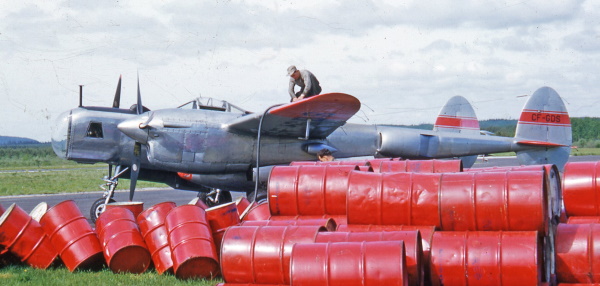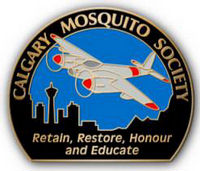
Click on any image for a slideshow!

Sooooo, Did We Get Anything Done This Year, So Far?
The Bomber Command Museum has been closed since December 11. Did we get any work done? Indeed, though less than any previous quarter since we began in August 2012. Read on to find out the what and the who and the wherefore.
Hurricane
Nothing to report. (Okay not a good start...)
Mosquito
Thanks to new bug restrictions, the Bomber Command Museum was forced to shut down all activities on December 11th, effectively bringing any onsite work to a halt. As that remains in effect until Phase 3 of the provincial reopening plan is instituted, almost all of the work for this quarter was done by a small number of volunteers with 'at home' projects.
Jack McWilliam
2021 started slower than we had hoped, but it is what it is.
Andy W. has been plugging away at the elevator weights (I call it a "bob weight") to near completion. I have provided him with a new project: The throttle bell cranks and fuel valve that pass through the main spar. The bearings are so rusted that there is zero movement in some of them, so we will see where these take us.

More of Andy's fine 'before and after' work on the elevator differential, or as Jack calls it, the 'bob weight'. (Photos by Andy Woerle)
Dick S. continues his work on the flaps at home in his garage, with Gary T. doing the same with the flaps from the other side of the wing. I was tasked with getting the hardware cleaned and recoated. As we have very limited access to our shop equipment (bead blaster, paint booth, etc.) I elected to powder coat the parts and try a Teflon coating on the hardware. We applied the Teflon both on the flap hardware, as well as to the crew seat, which I am working on. We have had issues with the powder coating being too thick and with our paint coming off too easily, hence our trying the Teflon coating, which so far seems to be working better, but has limited colour options (silver, red and black). The parts were returned to Dick for his work to continue with positive feedback on the Teflon.

The starboard, outboard flap in process with Dick. Here the layers of paint tell the story of the 'HMS's history with the PR blue exposed along the rib lines with Spartan's silver grey making up most of the fabric colour. When new, RS700's first wore the late war bomber camouflage scheme. (Photo Dick Snider)

After many hours of fine work by Dick S., we can see new birch ply skins being attached to the flap after the interior ribs were assessed, repaired and re-primed. (Photo Dick Snider)

Some of Gary T's fine handiwork in the port flap and wingtips. Most of the original internal structure has been preserved, but all components required new skins as the originals were badly weathered and suffering from numerous impact holes. Gary has also taken on the challenge of producing new wing tip light lenses.
Colette and I have started work on the pilot's seat, after I collected it from Nanton and brought it up to our shop at work. Over the past few months, Colette and I have made a few trips to Nanton to clean all the parts for recoating. While I bead blasted or cleaned, Colette did a job that is always nasty for ground crew, namely cleaning and paint stripping the wheel wells. Trust me when I say that these needed a good pressure wash before we started; an option which sadly was unavailable to us. The parts I was able to clean down at the Bomber Command Museum were then powder coated and Teflon coated for reassembly.

Before: The pilot's seat, relatively intact, though quite worn and aged. It included some Spartan mods such as replacing the armour plate back rest with plywood for weight saving. As well, one arm rest appears to be an 'aftermarket' modification.
This seat, as simple as it is, requires a lot of shims and farting around (technical talk). We are near completion on it, with more reassembly and shimming required.
Once the seat is done, it will head to the upholstery shop for new arm rest covers. Under a number of layers of some form of duct tape, the original green leather is visible, so we will have a color match for all the modellers to disagree about for all eternity.

And voila, after +80 hrs of labour and a lifetime’s worth of experience applied to the Mosquito pilot’s seat, its fit for a Falcon!
The wing is an area of consternation as we will have to design and create a new fixture to hold it rigid while allowing us to conduct structural repairs. I have some ideas, but this will take some planning and a larger team than 2 to accomplish. I will start looking for quotes on beams, hoping that they haven't gone up in price like 2x4's. At present, the wing is not supported other than at the main attach points. We will need more support as we dig deeper into the structure on the upper side.
Once the wing is in a new structure I hope to bring the landing gear out to start restoration on it which will be another milestone for 2021, that is, after we dig it out of storage (oh joy...).

Why does Jack say "oh joy" to removing the landing gear from storage? Because they are stored here, in a 53’ trailer. In winter it is always a balmy -30C and virtually inaccessible. Regardless, at any time of the year it is a place just waiting to strain and sprain old muscles or snap an ankle just for fun.
Events and Miscellaneous
Sadly we must begin with news that Hurricane 5389 pilot Gordon Hill passed away on January 30th. Gordon was the last person known to have flown this airplane and he was the star at the ceremonies and parties when we delivered the newly restored Hurricane back to the City of Calgary in November 2019. His full obituary can be found here:
Calgary Herald: Gordon Hill Obituary

Gordon Hill at the Hurricane handover event in November 2019. Gordon cut his teeth as a fighter pilot on this and the other Hurricanes of 133 Squadron, RCAF before heading overseas to fly combat with 416 Squadron.
We held our Annual General Meeting via Zoom on March 17th. It was attended by 30 members and all it all seemed to go quite smoothly. All serving board members agreed to retain their positions for another year and we added one new member, Michael Harrison who has been a very active restoration volunteer for quite a number of years now. Welcome Michael.
A regular feature of these meetings is to wrap up with a slideshow of our activities and accomplishments of the previous year. We posted a video version on YouTube at the request of several members. You can find it here:
March 2021 Annual General Meeting Slide Show
We took no time at all to foist work on Michael, handing him our provincial casino file. We were given the option to hold a casino early this year or defer until the fourth quarter, which we have done, hoping that all such facilities will be allowed to run at full capacity later in the year. Fingers crossed.
A few years back we were asked by author Gordon A. A. Wilson if we had any photos of one of our Merlin engines that he could include in his upcoming (now published) book about the engine. We were happy to supply a few and see a couple of them actually published. Gordon is now working on a new book, "The Engines of Bomber Command" and again asked if we could supply some images to illustrate his new book.
Again we have done so and hope to see one or more in his upcoming volume. Copies of Gordon's Merlin book are available here:
The Merlin: The Engine That Won the Second World War

Bomber Command Museum’s Lanc guru Greg Morrison guiding our team on how to reinstall the port bank on the Hurricane’s Merlin 29. This photo appeared in Wilson’s book, "The Merlin: The Engine That Won the Second World War."
Before Spartan Air Services operated Mosquitoes for aerial photo mapping, they tried to do the work with Lockheed P-38 Lightnings. There were many issues and difficulties with the type, which is why they bought 15 Mosquitoes in 1954. Interestingly, at least 2 of the original Spartan P-38s survive today, one of which is on display at the Experimental Aviation Association museum in Oshkosh, WI. At present, it is finished to represent the P-38 of America's top ace of World War II, Major Richard I. Bong's airplane, Marge.

Lightning CF-GDS on a 'DIY' fuel stop while working for Spartan Air Services. Now on display at the EAA Museum as Major Richard Bong's, Marge.
In February we were contacted by Chris Henry, the museum's Program Coordinator. He was preparing a Zoom delivered talk on the airplane and on Bong and wanted to know if we had any pictures of the airplane while in Spartan service. Indeed we did and we also put him onto Spartan historian Robert Stitt. Chris delivered the presentation to a worldwide audience of hundreds on March 9th. I sat in and appreciated that Chris was very generous with his praise of our work on both the Mosquito and the Hurricane and especially for our sharing a rare photo of the Lightning.
Last year we were approached by Rob Lennard, Alberta's 'History Wrangler', to supply some information about the Mosquito and Hurricane, which we were happy to do. Rob is a much published author, educator, singer/songwriter and recipient of the 2019 City of Calgary Award for Heritage. Rob is also working on two television series and asked if we could work with him to create a dozen or so short segments on vintage military aircraft including the Mosquito and Hurricane. In March we shot a series of vignettes at the Hangar Flight Museum and at the Bomber Command Museum which we hope to see on the air in the near future. As well, Rob's upcoming book includes some of our members and our airplanes as characters in his young adult Canadian military history book.
That's it for now. Here's hoping for a more productive second quarter to 2021.

Richard de Boer, President
April 6, 2021

Website - Calgary Mosquito Aircraft Society


